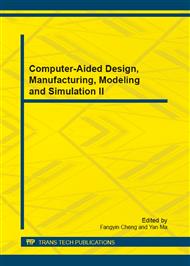[1]
C. Boemare and P. Quirion: Implementing greenhouse gas trading in Europe: lessons from economic literature and international experiences. Ecological Economics Vol. 43 (2002), pp.213-230.
DOI: 10.1016/s0921-8009(02)00213-6
Google Scholar
[2]
S. R. Milliman and R. Prince: Firm incentives to promote technological change in pollution control. Journal of Environmental Economics and Management Vol. 17 (1989), pp.247-265.
DOI: 10.1016/0095-0696(89)90019-3
Google Scholar
[3]
C.W. Howe: Taxes versus tradable discharge permits: a review in the light of the U.S. and European experience. Environmental and Resource Economics Vol. 4 (1994), pp.151-169.
DOI: 10.1007/bf00692201
Google Scholar
[4]
T. H. Edwards and Hutton J P: Allocation of carbon permits within a country: a general equilibrium analysis of the United Kingdom. Energy Economics Vol. 23 (2001), pp.371-386.
DOI: 10.1016/s0140-9883(00)00077-3
Google Scholar
[5]
D. Burtraw, K. Palmer and R. Bharvirkar: The effect of allowance allocation on the cost of carbon emission trading (RFF Discussion Paper 2001).
Google Scholar
[6]
K. Rehdanz and R. Tol: Unilateral regulation of bilateral trade in greenhouse gas emission permits. Ecological Economics Vol. 54 (2005), pp.397-416.
DOI: 10.1016/j.ecolecon.2004.08.009
Google Scholar
[7]
T. N. Cason: What can laboratory experiments teach us about emissions permit market design? Agricultural and Resource Economics Review Vol. 39 (2010), pp.151-161.
DOI: 10.1017/s1068280500007218
Google Scholar
[8]
G. T. Svendsen and J. L. Christensen: The US SO2 auction: analysis and generalization. Energy Economics Vol. 21 (1999), pp.403-416.
DOI: 10.1016/s0140-9883(99)00004-3
Google Scholar
[9]
T.N. Cason and C. R. Plott: EPA's new emissions trading mechanism: a laboratory evaluation. Journal of Environmental Economics and Management Vol. 30 (1996), pp.133-160.
DOI: 10.1006/jeem.1996.0010
Google Scholar
[10]
J. K. Goeree, C. A. Holt, K. Palmer, W. Shobe and D. Burtraw: An experimental study of auctions versus grandfathering to assign pollution permits (Working Paper 2009).
DOI: 10.2139/ssrn.1552130
Google Scholar
[11]
C. L. Kling and J. Zhao: On the long-run efficiency of auctioned vs. free permits. Economics Letters Vol. 69 (2000), pp.235-238.
DOI: 10.1016/s0165-1765(00)00291-3
Google Scholar
[12]
R. Betz, S. Seifert, P. Cramton and S. Kerr: Auctioning greenhouse gas emissions permits in Australia. The Australian Journal of Agricultural and Resource Economics Vol. 54 (2010), pp.219-238.
DOI: 10.1111/j.1467-8489.2010.00490.x
Google Scholar
[13]
P. Cramton and S. Kerr: Tradable carbon permit auctions: how and why to auction not grandfather. Energy Policy Vol. 30 (2002), pp.333-345.
DOI: 10.1016/s0301-4215(01)00100-8
Google Scholar
[14]
D. Burtraw, J. Goeree, C. A. Holt, E. Myers, K. Palmer and W. Shobe: Collusion in auctions for emission permits: an experimental analysis. Journal of Policy Analysis and Management Vol. 28 (2009), pp.672-691.
DOI: 10.1002/pam.20460
Google Scholar
[15]
N. Kahana, Y. Mealemc and S. Nitzan: A complete implementation of the efficient allocation of pollution. Economics Letters Vol. 101 (2008), pp.142-144.
DOI: 10.1016/j.econlet.2008.07.003
Google Scholar


